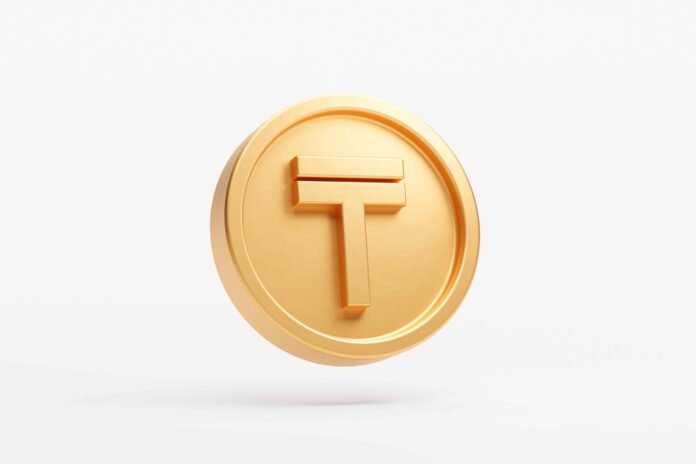Table of Contents
The Tether (USDT) Debate: To Invest or Not to Invest?
Cryptocurrency is a rapidly expanding industry that has gained significant popularity in recent years. However, investing in cryptocurrencies can be risky due to the volatile nature of their prices. This is where stablecoins come into play, with Tether (USDT) being one of the most widely used and well-known stablecoins on the market.
In essence, Tether (USDT) is a cryptocurrency that is pegged to the value of the US dollar. This means that for every USDT issued, there should be an equivalent amount of USD held in reserve by Tether Limited, the company behind USDT.
The goal is to provide stability and predictability in pricing for users who want to trade cryptocurrencies without constantly risking market volatility. While USDT has been around since 2014 and has gained significant traction within the crypto community, it is important for potential investors to understand both the benefits and risks associated with investing in this stablecoin.
What Exactly Is Tether (USDT)?
Tether (USDT) operates using blockchain technology and functions as a digital asset that enables users to transact with traditional fiat currencies like USD or Euros without having to rely on traditional banking systems. Every unit of USDT released should have an equivalent value in USD held by Tether Limited as a reserve.
This feature makes it attractive for traders who want stability when dealing with cryptocurrencies. Because trading non-stable coins can lead to extreme price fluctuations and no guarantee on returns if not closely monitored.
Why You Need To Understand The Risks And Benefits Of Investing In USDT
Any form of investment carries its own set of risks and rewards; however, there are certain aspects of USDT’s operation that require closer scrutiny from potential investors. For example, some critics argue that there may not be enough US dollars to back up all the USDT currently in circulation, and this can lead to a collapse of the whole market if Tether Limited cannot meet its obligation.
Similarly, there are also concerns about whether or not Tether Limited is transparent enough in revealing how much USD it holds in reserve. This lack of transparency has led to speculation that the company may be using USDT to manipulate cryptocurrency prices, which could pose significant risks for investors.
Investing in Tether (USDT) requires an understanding of both the potential benefits and risks associated with its operation. Before making any financial decisions, it is essential that potential investors do their due diligence and research thoroughly before investing in this stablecoin.
What is Tether (USDT)?
Definition and Explanation of USDT
Tether, also known as USDT, is a stablecoin that is pegged to the value of the U.S. dollar. Essentially, it’s a digital token that represents one U.S. dollar and can be traded on various cryptocurrency exchanges. Tether was launched in 2015 and quickly gained popularity among traders who wanted to invest in cryptocurrencies without dealing with their inherent volatility.
Unlike other cryptocurrencies such as Bitcoin or Ethereum, which can fluctuate wildly in value from day to day, Tether maintains a stable value of 1 USD per token. This stability makes it attractive for those who want to protect their assets from market volatility or convert them into something less risky.
How it Works and Where it Can be Used
Tether works by using blockchain technology to create a transparent ledger that records all transactions made with the currency. Each USDT token is backed by an equal amount of actual U.S. dollars held in reserve by the company behind Tether.
The company claims that this reserve ensures the stability of the currency and allows users to buy and sell USDT on various cryptocurrency exchanges around the world. In addition to trading on exchanges, USDT can also be used for transactions such as paying for goods or services online.
Comparison to Other Stablecoins
There are several other stablecoins available on the market besides Tether, each with its own advantages and disadvantages. For example, USD Coin (USDC) was created by Coinbase and Circle as an alternative to Tether with more transparency around its reserves. Another popular stablecoin is TrueUSD (TUSD), which also claims to have greater transparency than Tether.
However, despite competition from other stablecoins, Tether remains one of the most widely used cryptocurrencies due to its long-standing reputation and ease of use. Additionally, Tether has been involved in several controversies over the years, which we’ll cover in detail later in this article.
Rational Move: Benefits of Investing in USDT
Stability and Predictability Compared to Other Cryptocurrencies
One of the main reasons why investing in USDT can be a rational move is due to its stability compared to other cryptocurrencies. As a stablecoin, USDT is designed to maintain a 1:1 value ratio with the US dollar. This means that unlike other cryptocurrencies, which can experience significant price swings on a daily basis, the value of USDT remains relatively consistent over time.
This stability makes USDT an attractive investment option for those who want to avoid the volatility associated with other cryptocurrencies. It also makes it a useful tool for traders who want to hedge their positions during market downturns.
Protection Against Market Volatility
Another benefit of investing in USDT is that it provides protection against market volatility. Because its value is tied to that of the US dollar, investors in USDT can avoid some of the risks associated with investing in traditional cryptocurrencies like Bitcoin and Ethereum.
During times when the cryptocurrency market experiences significant downturns or crashes, investors who hold USDT may be able to ride out these periods without suffering significant losses. This protection against market volatility can be especially appealing for those who are looking to invest in cryptocurrency while minimizing their risk exposure.
Convenient for Trading on Exchanges That Don’t Accept Fiat Currency
Investing in USDT can be a rational move because it provides a convenient way for traders to buy and sell cryptocurrencies on exchanges that don’t accept fiat currency (such as USD or EUR). Because USDT represents an equivalent value to USD, many exchanges accept it as a form of payment. This means that traders can use their holdings of USDT as a gateway currency when trading between different cryptocurrencies on these exchanges.
Overall, while there are risks associated with investing in any cryptocurrency, USDT provides a level of stability and predictability that can make it an attractive option for risk-averse investors. Its usefulness as a trading tool on exchanges that don’t accept fiat currency is another benefit that may make it worth considering as part of a diversified cryptocurrency portfolio.
Risky Bet: Potential Risks of Investing in USDT
Lack of transparency surrounding the company’s reserves
One of the most significant risks associated with investing in Tether (USDT) is the lack of transparency surrounding the company’s reserves. Although Tether has claimed that each USDT token is backed by a one-to-one ratio with US dollars, there have been concerns about whether this is entirely true. There has been speculation and doubt about whether Tether had enough reserves to support all outstanding USDT tokens.
Some experts suggest that if all users redeemed their tokens at once, Tether would not be able to cover all demands. This lack of transparency has given rise to many controversies, and it remains a significant criticism and concern for potential investors.
Legal concerns and regulatory issues
Another risk that investors should consider before investing in Tether (USDT) relates to legal concerns and regulatory issues. There are still few regulations governing cryptocurrencies around the world; however, some countries have begun implementing regulations on digital assets. Tether (USDT) has come under scrutiny by several regulatory institutions over recent years.
In 2018, the New York Attorney General’s office sued Bitfinex (which owns Tether), alleging that they covered up a loss of $850 million by transferring funds from Tether’s reserves without disclosing it publicly. This incident led to questions about whether or not Tether was operating legally.
Possibility for market manipulation
There are genuine concerns about the possibility for market manipulation when it comes to investing in Tether (USDT). Since its inception, there have been allegations that market manipulators use USDT as a tool to influence cryptocurrency prices artificially. Some experts believe that individuals or organizations can use USDT tokens to buy other cryptocurrencies and drive up their prices artificially.
The fact remains that the market can be subject to manipulation and investors should remain vigilant when investing in Tether (USDT). Investors must weigh all the pros and cons before investing in Tether (USDT).
Although it is an attractive option for those looking to hedge their bets against cryptocurrency market volatility, there are risks associated with any investment. Lack of transparency surrounding reserves, legal concerns and regulatory issues, and possibility for market manipulation are some of the risks that investors should consider before taking the plunge.
Controversies Surrounding Tether (USDT)
Tether (USDT) has been surrounded by controversies from its inception. One of the main controversies that have plagued USDT is the allegation of price manipulation.
It is alleged that Tether Limited, the company behind USDT, issued tokens without backing them with actual dollars and then used those tokens to buy other cryptocurrencies, thereby inflating their prices. This would artificially increase demand for cryptocurrencies and lead to a rise in prices.
The company has denied any wrongdoing and has insisted that all USDT tokens are backed by actual dollars. Another controversy surrounding Tether (USDT) is its connection to Bitfinex exchange.
Bitfinex was one of the first exchanges to list USDT and has since become one of its largest users. The exchange’s close association with Tether Limited has led to concerns about potential conflicts of interest.
In 2018, it was revealed that Bitfinex had borrowed $850 million from Tether’s reserves in order to cover up losses from a hack. While both companies denied any wrongdoing, this revelation raised questions about the transparency and stability of USDT.
Allegations of Price Manipulation
The allegations of price manipulation surrounding Tether (USDT) have been widely discussed within the cryptocurrency industry for several years now. Critics argue that the company is issuing tokens without actually having sufficient reserves in place to back them up, thereby artificially inflating demand for cryptocurrencies such as Bitcoin. This can lead to a rise in prices that may not be justified by market conditions, leading investors into making decisions based on flawed information.
Tether Limited denies these allegations and maintains that all USDT tokens are fully backed by actual dollars held in reserve accounts. However, audits conducted on behalf of the company have been criticized for being incomplete or lacking transparency, fueling suspicions among investors.
Connection to Bitfinex Exchange and Potential Conflicts of Interest
One of the biggest controversies surrounding Tether (USDT) is its close connection to Bitfinex exchange. The two organizations share common management, and it is believed that Bitfinex uses USDT tokens extensively on its platform.
This has led some critics to question whether there are potential conflicts of interest at play, with Tether Limited using USDT tokens to prop up prices on Bitfinex or other exchanges. In 2018, it was revealed that Bitfinex had borrowed $850 million from Tether’s reserves in order to cover up losses from a hack.
This revelation raised concerns about the stability of USDT, as investors questioned whether the company actually had enough reserves in place to back up all outstanding tokens. While both companies denied any wrongdoing, this incident highlighted the need for greater transparency and oversight within the cryptocurrency industry.
Conclusion: Should You Invest in Tether (USDT)?
Weighing the Pros and Cons
After considering both the benefits and risks of investing in Tether (USDT), it is clear that there is no clear-cut answer to whether or not you should invest. On one hand, USDT provides stability and predictability compared to other cryptocurrencies, making it a rational move for those who want to protect themselves against market volatility.
Additionally, USDT can be incredibly convenient for trading on exchanges that don’t accept fiat currencies. However, there are also several risks associated with investing in USDT.
The lack of transparency surrounding the company’s reserves is concerning, as well as potential legal issues and allegations of market manipulation. Furthermore, the connection between Tether and Bitfinex raises red flags about conflicts of interest.
Factors to Consider Before Investing in USDT
Before deciding whether or not to invest in USDT, it’s important to carefully consider your own personal situation and goals. If you’re new to cryptocurrency investing and looking for a stable option with low volatility, USDT might be an attractive choice.
However, if you’re more experienced or looking for long-term investments with high returns potential, other options may be more suitable. Additionally, it’s crucial to do your own research on Tether (USDT) before making any investment decisions.
Look into their reserves policy and regulatory compliance status. Keep an eye out for any significant changes or news regarding the company that could impact its value.
While Tether (USDT) does offer some benefits for certain types of investors, there are also significant risks involved that must not be ignored when making investment decisions related to this cryptocurrency. As with any investment particularly those involving newer technologies such as cryptocurrencies careful consideration and due diligence are key when determining whether or not something is right for you.



